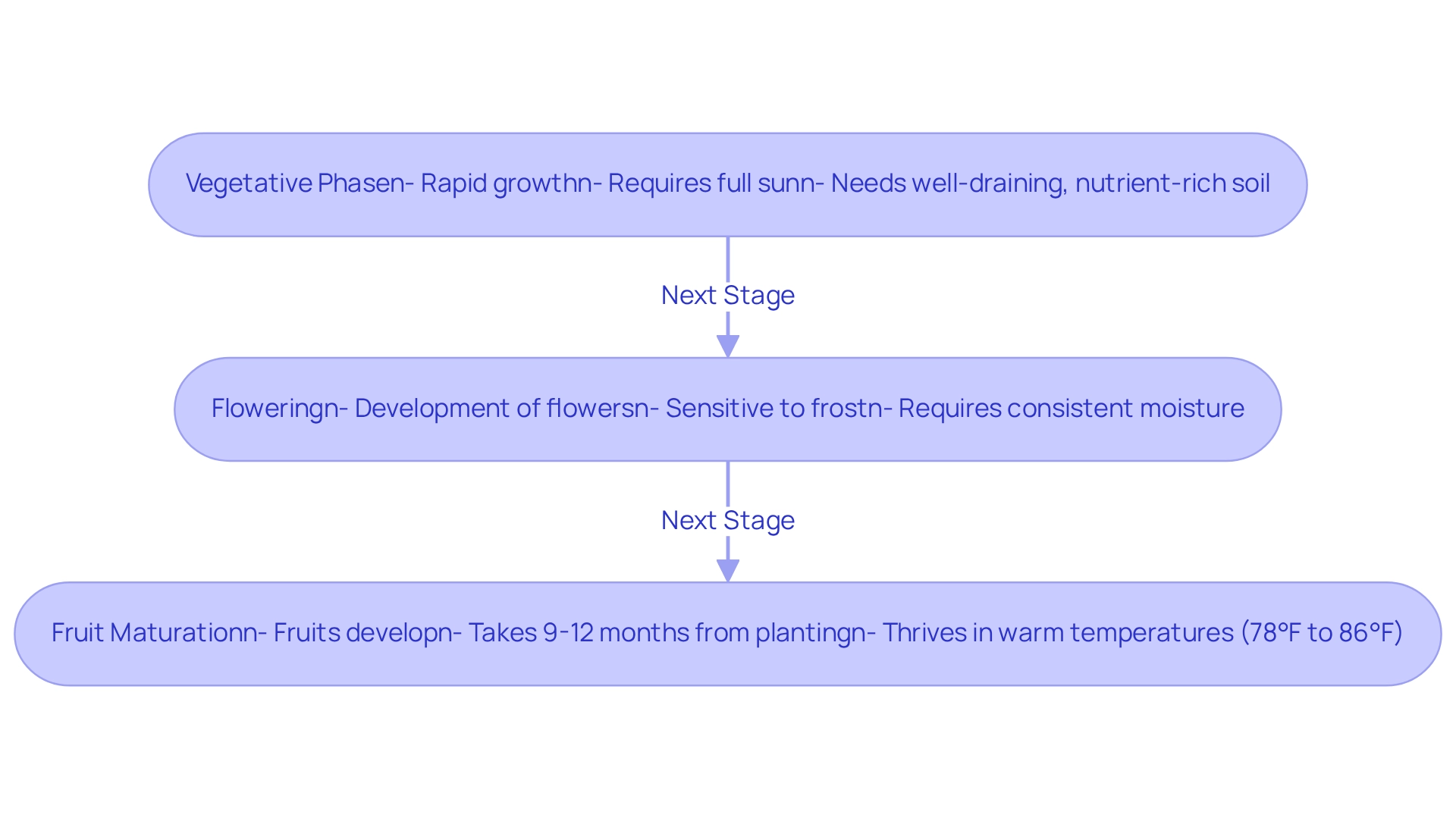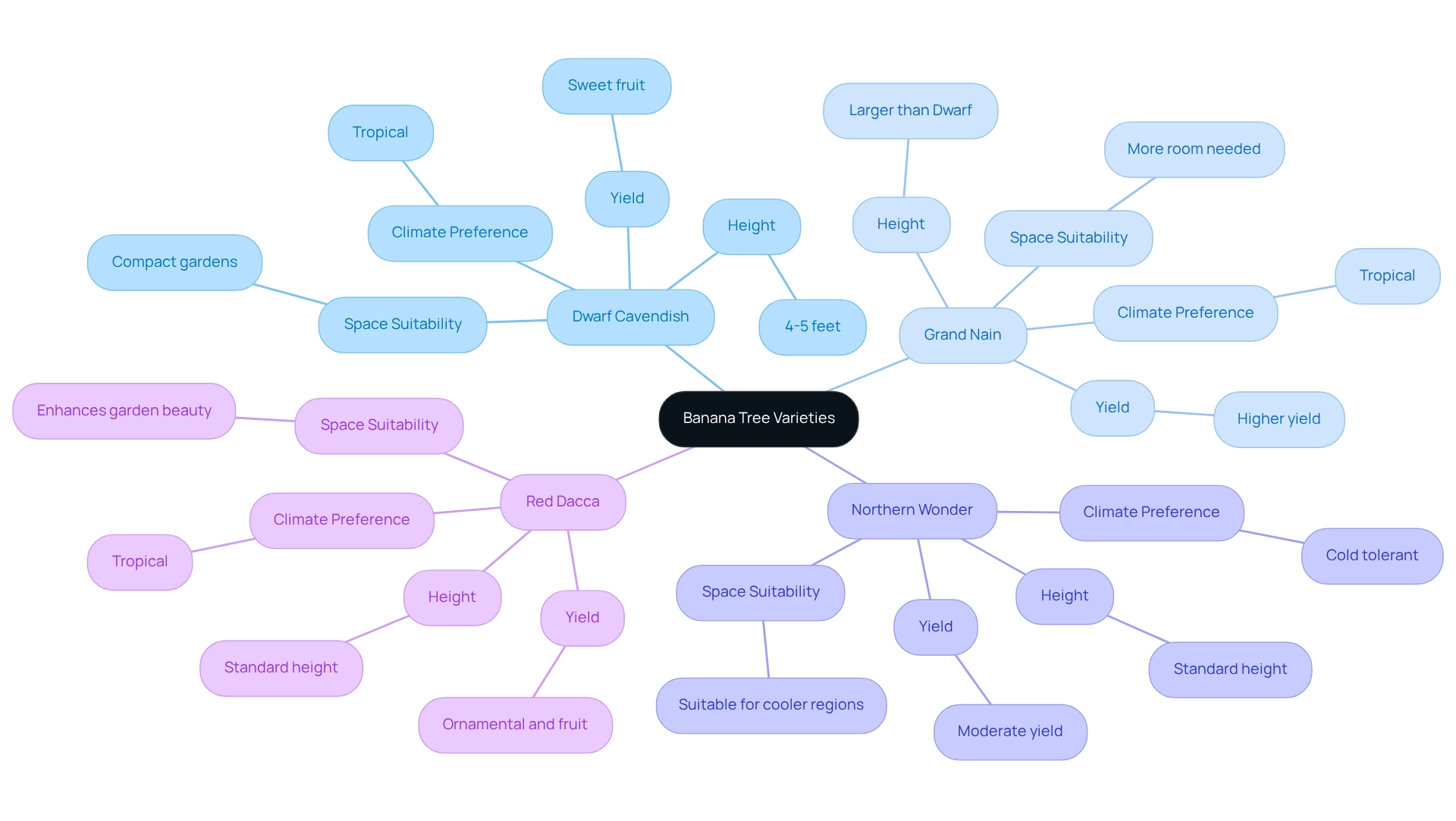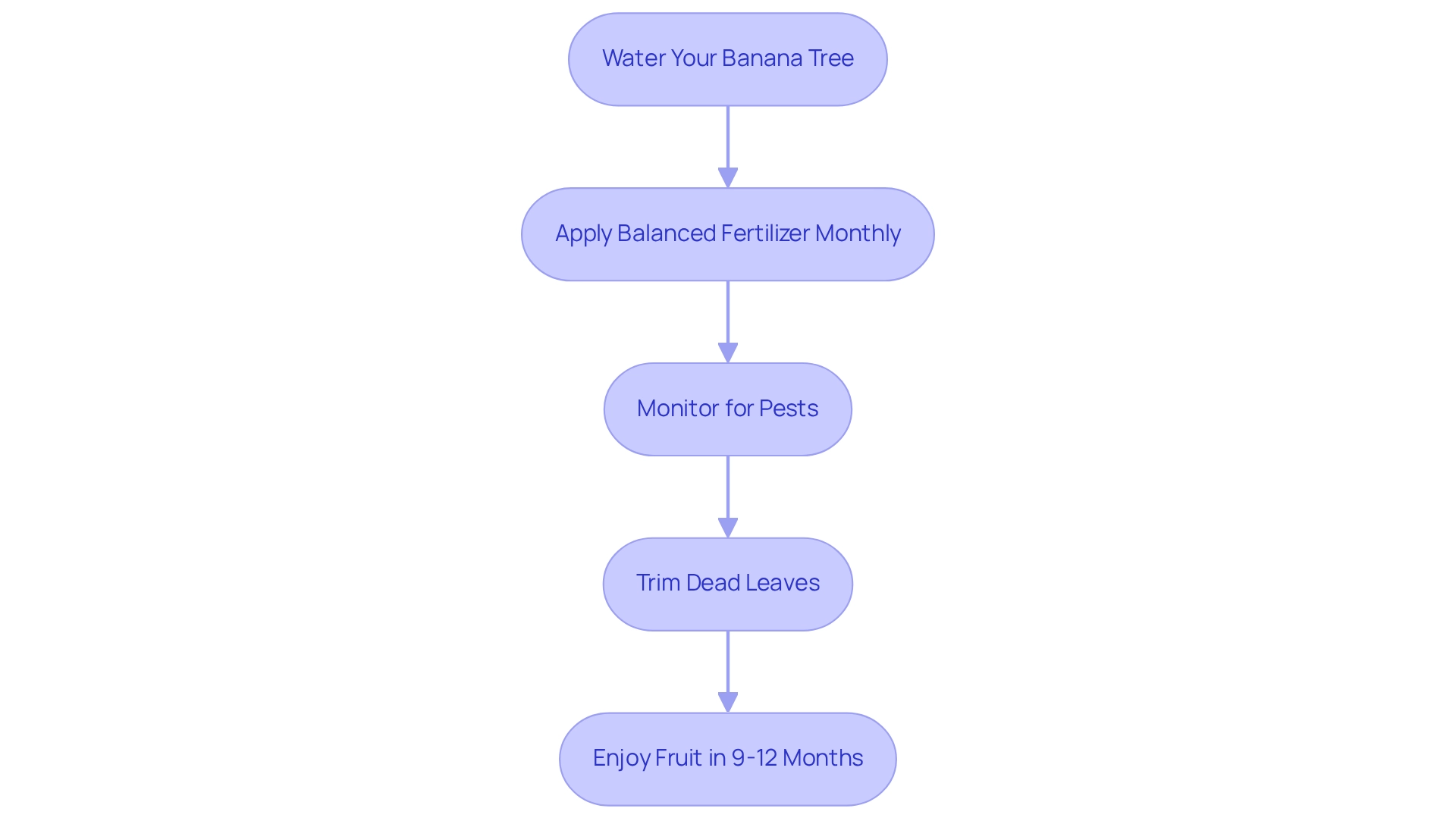Growing a tiny banana tree can be a rewarding adventure, and with a little guidance, you can nurture it to success. To embark on this journey, there are four essential steps to follow:
- Understanding the growth requirements
- Selecting the right variety
- Preparing and planting the tree
- Maintaining its care
Many gardeners face challenges like ensuring proper sunlight, soil conditions, and consistent moisture. By addressing these concerns, you can create a thriving environment for your banana plant.
Imagine watching your banana tree flourish with the right attention! It’s crucial to pay careful attention to pests and fertilization, as these factors play a significant role in ensuring fruitful yields. With dedication and the right care, you can look forward to enjoying the fruits of your labor within just 9 to 12 months. Remember, every step you take is a step towards a beautiful garden filled with life and growth.
Introduction
In the vibrant world of gardening, few plants capture the enchanting spirit of the tropics like the banana tree. With their broad, lush leaves and remarkable growth, these herbaceous beauties not only enhance our gardens but also promise the delightful reward of sweet, delicious fruit. Yet, nurturing banana trees is more than just having a green thumb; it requires a heartfelt understanding of their unique growth cycles, environmental needs, and the right variety selection.
Have you ever felt overwhelmed by the challenges of gardening? You're not alone! From selecting the perfect spot to providing the right care, this comprehensive guide is here to support you. Together, we'll explore the essentials of banana tree cultivation, helping you transform your outdoor space into a thriving tropical paradise. Whether for personal enjoyment or as a fruitful contribution to your community, the journey of growing bananas is not only rewarding but also enriching.
So, let's embark on this adventure together, nurturing our gardens and ourselves along the way!
1. Understand the Basics of Banana Trees
Banana plants (Musa spp.) are tropical wonders that flourish in warm, humid environments, showcasing their broad leaves and rapid growth. Though often referred to as woody plants, they are, in fact, large herbaceous species. Understanding their growth cycle is essential for successful cultivation, which typically unfolds in three key stages:
- The vegetative phase
- Flowering
- Fruit maturation
Each phase plays a vital role in the plant's lifecycle. To thrive, these plants need full sun, ideally soaking up at least 12 hours of direct sunlight each day, and they prefer well-draining, nutrient-rich soil. They are sensitive to frost and should be protected from chilly conditions, thriving best in temperatures between 78°F and 86°F (26°C to 30°C).
Recent studies highlight the importance of providing the right care during each developmental phase. Did you know that the journey from planting to harvesting fruit usually spans nine to twelve months? This timeline is crucial for us as gardeners to plan our cultivation effectively. The global industry surrounding this fruit, generating approximately USD 8 billion annually, underscores the significance of this crop for many producing nations, deeply impacting their agricultural economies.
For optimal growth, these plants also require consistent moisture and protection from strong winds. By understanding these needs and utilizing materials from Everglades Farm's Tropical Treasures & More collection—such as the Fast-Growing Plants collection and professional-grade fertilizers—we can successfully cultivate tropical plants, bringing a delightful taste of the tropics to our backyards. Imagine the joy of stepping into your garden and seeing these lush plants thriving, a testament to your nurturing care!
2. Choose the Right Banana Tree Variety
When selecting a
plant variety, it’s important to consider factors like available space, climate, and your gardening goals. The Dwarf Cavendish banana, known as a tiny banana tree, is a delightful option, growing to about 4-5 feet tall, making it ideal for compact gardens. This charming tiny banana tree variety thrives in smaller spaces and rewards you with sweet, delicious fruit. If you have a bit more room, the Grand Nain offers a larger size and higher yield, perfect for those looking to maximize their harvest.
For gardeners in cooler regions, the Northern Wonder is a wonderful choice due to its cold tolerance, ensuring it flourishes even in less favorable conditions. Ornamental varieties, such as the Red Dacca, can also enhance the beauty of your garden while still providing fruit. Understanding the specific growth habits and care requirements of each variety, such as the tiny banana tree, is crucial for a successful planting experience. Regular pruning and attentive care can significantly boost fruit yield, especially for smaller varieties.
Have you ever wondered how to make the most of your garden space? A case study titled 'Maximizing Fruit Production in Small Gardens' suggests that these practices can lead to improved yields, making them especially beneficial for home gardeners like you. It’s also worth noting that the Brazilian fruit output has seen a slight reduction of 1 percent from 1991 to 2.3 million pounds, reflecting broader industry trends that may impact availability.
By exploring and selecting the right fruit plants, you can cultivate a vibrant and productive garden. As Gait Fee Chung wisely points out, controlling wild banana weeds with herbicides can be an effective strategy for maintaining a healthy planting environment. Together, let’s nurture your garden into a flourishing space that brings joy and abundance.
3. Prepare and Plant Your Banana Tree
Getting ready to plant your soursop trees is an exciting journey, and choosing a sunny spot with well-draining soil is the perfect start. We all know how important it is to enrich our garden beds, so consider adding organic matter like compost or well-rotted manure. This will greatly enhance the nutrient content, creating a nourishing environment for your plants. Aim for slightly acidic soil, ideally between pH 5.5 and 6.5, as this is where soursop thrives best.
When you're ready to dig,
make a hole that is twice the width of the root ball and deep enough to accommodate the roots without bending them. Position your tree vertically in the hole, ensuring that the top of the root ball is level with the ground surface. As you fill in with soil, gently pack it down to eliminate any air pockets—this small step can make a big difference. After planting, don’t forget to water thoroughly; this helps settle the soil around the roots, giving them a strong start.
If you're planting several trees, remember to space them at least 8-10 feet apart. This allows for their expansive growth and ensures that each tree has enough room to flourish. Additionally, consider implementing pest management practices. Regularly monitor for pests and use organic pesticides when necessary. By taking these steps, you're not just fostering healthy development; you're also enhancing the overall vitality of your garden. Remember, every little effort counts, and together, we can cultivate a thriving garden!
4. Maintain and Care for Your Banana Tree
To help your fruit plant thrive, regular attention is essential. Water your tiny banana tree consistently, ensuring the soil remains moist but not soggy, as tiny banana trees are especially sensitive to overwatering. During the growing season, apply a balanced fertilizer rich in potassium, nitrogen, and magnesium each month to encourage robust growth and fruitful yields.
It's also important to keep an eye out for pests like aphids and spider mites; if you notice any infestations, address them promptly with organic insecticides or neem oil to safeguard your plant. Trimming away dead or damaged leaves from your tiny banana tree will not only foster new growth but also improve air circulation around it.
With diligent care, your tiny banana tree can produce fruit within 9 to 12 months after planting, rewarding your efforts with delicious bananas. Many satisfied customers have shared their positive experiences with Everglades Farm, emphasizing the quality of their tropical plants. For example, Jim C. from Mauritius praised the quality of his Mauritius lychee tree, sharing, 'My Mauritius lychee tree arrived in just a couple of days and in perfect condition.'
Testimonials like these highlight the
exceptional service and product quality that Everglades Farm offers, making it a trusted choice for home gardeners. So, let’s nurture our plants together and enjoy the fruits of our labor!
Conclusion
Cultivating banana trees is not just a gardening task; it’s a rewarding journey that brings the enchanting beauty of the tropics right into your backyard. We understand that navigating the growth cycles, environmental needs, and care techniques can feel daunting. However, each step—from selecting the right variety to preparing the soil and nurturing your trees—plays a crucial role in fostering healthy, fruitful plants.
Choosing the right banana tree variety that suits your specific conditions and preferences is essential for achieving optimal growth and abundant fruit. Whether you lean towards the compact Dwarf Cavendish or the high-yield Grand Nain, this choice can truly transform your gardening experience. Remember, implementing proper planting techniques and maintaining your plants with regular watering and pest management are vital to their success.
Ultimately, the experience of growing banana trees enriches not only your personal garden but also the surrounding environment. With a little dedication and care, the sweet reward of delicious fruit is merely months away, making every effort worthwhile. Embracing the art of banana tree gardening is your step towards creating a lush, tropical oasis, while enjoying the myriad benefits of this remarkable plant. So, let’s embark on this gardening adventure together, nurturing not just plants, but also our connection to nature.
🌴 Bring Home a Truly Tiny Banana Tree Today
Start your banana-growing journey with Everglades Farm. Our healthy, high-quality trees and expert support make it easy and fun to grow delicious fruit at home.
👉 Order the Truly Tiny Banana Tree Now and transform your backyard into a lush, productive paradise.
Frequently Asked Questions
What are banana plants, and what environments do they thrive in?
Banana plants (Musa spp.) are tropical plants that flourish in warm, humid environments, characterized by their broad leaves and rapid growth.
What are the key stages in the growth cycle of banana plants?
The growth cycle of banana plants typically unfolds in three key stages: the vegetative phase, flowering, and fruit maturation.
How much sunlight do banana plants need for optimal growth?
Banana plants need full sun, ideally soaking up at least 12 hours of direct sunlight each day.
What type of soil is best for growing banana plants?
Banana plants prefer well-draining, nutrient-rich soil for optimal growth.
What temperature range is ideal for banana plants?
Banana plants thrive best in temperatures between 78°F and 86°F (26°C to 30°C) and are sensitive to frost.
How long does it typically take for banana plants to go from planting to harvesting fruit?
The journey from planting to harvesting fruit usually spans nine to twelve months.
What is the economic significance of banana plants globally?
The global industry surrounding bananas generates approximately USD 8 billion annually, significantly impacting the agricultural economies of many producing nations.
What additional care do banana plants require for optimal growth?
For optimal growth, banana plants require consistent moisture and protection from strong winds.
How can gardeners successfully cultivate banana plants?
Gardeners can successfully cultivate banana plants by understanding their needs and utilizing materials like professional-grade fertilizers and fast-growing plants from collections like Everglades Farm's Tropical Treasures & More.









0 comments